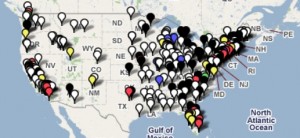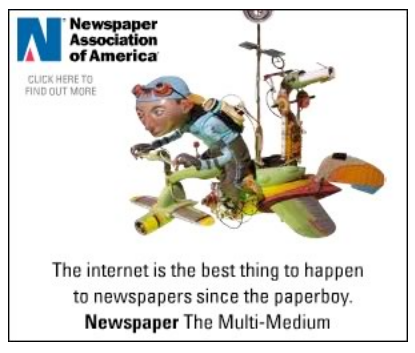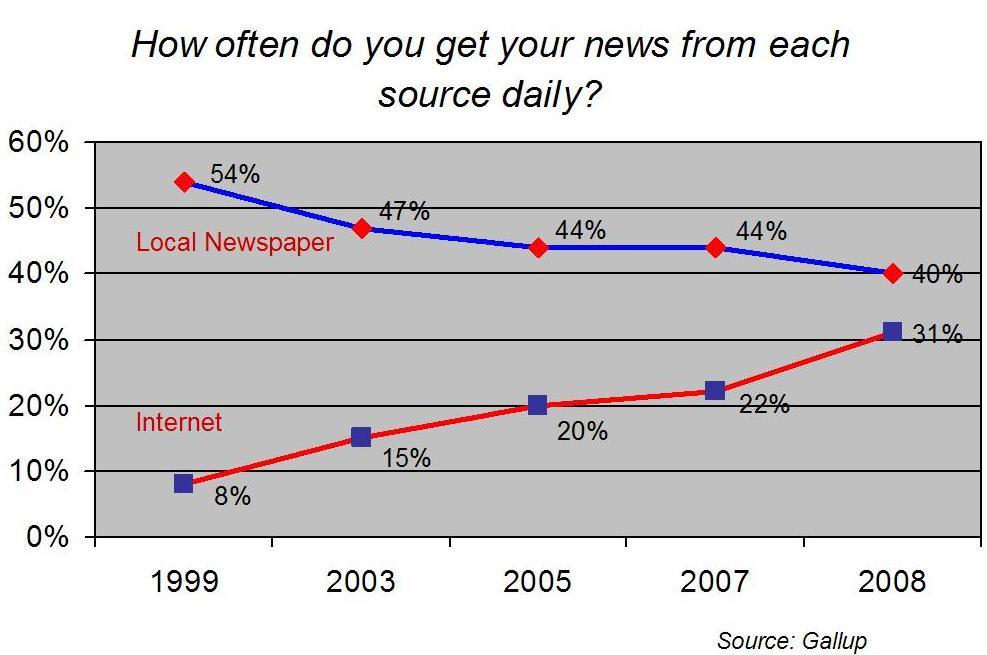We sorted through our 147 entries of 2008 to come up with the stories that surprised us, delighted us or made us shake our heads in disbelief. We’ll present them as a series of posts over the next few days in hopes that you’ll find them to be as memorable as we did. Happy New Year!
Telling Tales
Gallup research showed that 31% of US adults now consult the Internet daily for news while 40% read a local newspaper. The trend lines look to cross sometime in the next five years, making the Internet the most important news source among US adults. Only 22% of adults under 30 read a local newspaper daily, Gallup reported. The average daily newspaper reader is now 56 years old.
Ted Gup, a journalism professor at Case Western, lamented his students’ appalling ignorance of basic current events. “Nearly half of a recent class could not name a single country that bordered Israel. In an introductory journalism class, 11 of 18 students could not name what country Kabul was in, although we have been at war there for half a decade. Last fall only one in 21 students could name the U.S. secretary of defense. Given a list of four countries – China, Cuba, India, and Japan – not one of those same 21 students could identify India and Japan as democracies.
 Rick Redfern, the resident ink-stained wretch of the Doonesbury comic strip for more than 30 years, decided to accept a buyout
Rick Redfern, the resident ink-stained wretch of the Doonesbury comic strip for more than 30 years, decided to accept a buyout
The Wall Street Journal’s paid subscription model has often been held up as an example of how newspapers need to buck the trend toward free content. However, in April, website Salon revealed how to get full access to The Wall Street Journal for free instead of paying $79 annually. It turns out the Journal creates a shadow version of its web content for the express purpose of getting traffic from Google, which can’t see around firewalls.
In May, Mike Koehler launched Praying for Papers, a blog whose stated purpose was to encourage “anyone who is touched by this shift in our industry to include it each day in their prayer life.” On July 11, the author said he was going on vacation. The blog hasn’t been updated since.
Shortly before the stock market meltdown, Valleywag observed that the combined wealth of Google’s co-founders exceeded the value of the entire US newspaper industry
The fifth annual “State of the American News Media” study by the Project for Excellence in Journalism found that as newspapers cut staff, they actually concentrated their remaining resources in fewer places. “You have in a sense more reporters across more outlets, but they are all covering a fairly narrow band of stories,” the project’s director told Reuters.
 Jolly Journalist debuted in June, asserting that “these are the most exciting times to work in journalism. We want to collect your reasons why this is the case.” It hasn’t been updated since Oct. 13.
Jolly Journalist debuted in June, asserting that “these are the most exciting times to work in journalism. We want to collect your reasons why this is the case.” It hasn’t been updated since Oct. 13.
Watchdogs
Cost-cutting is robbing the public of an American institution – the editorial cartoonist. “In the past three years, around three dozen artists have been laid off, forced to take buyouts or to retire, according to the Association of American Editorial Cartoonists,” said an Associated Press piece.
The ombudsman, a staff watchdog position that became popular in the 1970s, turned into an expensive luxury. “Over the past year, reader representatives/public editors/reader advocates/ombudsmen have been reassigned, retired or bought out at the Baltimore Sun, the Minneapolis Star Tribune, the Orlando Sentinel, the Fort Worth Star-Telegram and the Palm Beach Post,” wrote Karen Hunter, the Hartford Courant‘s reader representative, in a farewell column that has since been pulled off the site.
 Erica Smith vividly documented the industry’s massive layoffs using a Google Maps mashup.
Erica Smith vividly documented the industry’s massive layoffs using a Google Maps mashup.
The Gannett Blog became a major source of news about job cuts at the company.  Only the site isn’t run by Gannett but rather by a former employee, Jim Hopkins. The New York Times cited Gannett as a poster child of corporate cluelessness because it refuses to pay attention to the blog, despite the fact that Hopkins’ posts can draw hundreds of comments. Hopkins assembled field reports from employees at more than 70 newspapers about recent layoffs, making the blog the most comprehensive source of news about that topic.
Only the site isn’t run by Gannett but rather by a former employee, Jim Hopkins. The New York Times cited Gannett as a poster child of corporate cluelessness because it refuses to pay attention to the blog, despite the fact that Hopkins’ posts can draw hundreds of comments. Hopkins assembled field reports from employees at more than 70 newspapers about recent layoffs, making the blog the most comprehensive source of news about that topic.
Clue, Please
The American Press Institute held an executive confab in Reston, Va. In November in which industry honchos heard that the newspaper industry is in a full-blown crisis. All but one of the public companies in the room was at real risk of bankruptcy, a summary said. Session leader James Shein said one of the purposes of the meeting was to “illuminate for newspaper industry leaders the urgency of their situation.” Executives agreed to meet again in six months.
 The Newspaper Association of America continues to run these strange ads with their baffling images, apparently thinking it’s doing some good. What the heck is that thing?
The Newspaper Association of America continues to run these strange ads with their baffling images, apparently thinking it’s doing some good. What the heck is that thing?
The executive editor of the Raleigh News & Observer wrote a stirring column about the growth of the newspaper’s overall print and online circulation. Underscoring the importance of the online product and readership trends in that direction, he cited several online sources, but didn’t link to any of them.
Sincerest Form of Flattery
Web wunderkind Marc Andreessen announced a New York Times death watch.
 And Advertising Age launched a series of articles intended to “look at the thought leaders in the industry, their attempts to leave the past — and even formats — behind and their strategies for finding new business models. The series title: The Newspaper Death Watch.
And Advertising Age launched a series of articles intended to “look at the thought leaders in the industry, their attempts to leave the past — and even formats — behind and their strategies for finding new business models. The series title: The Newspaper Death Watch.
Comments
This entry was posted on Thursday, January 1st, 2009 at 11:00 am and is filed under Fake News, Hyper-local. You can follow any responses to this entry through the RSS 2.0 feed. Both comments and pings are currently closed.




[…] Newspaper Industry and the Arrival of the Glaciers Newspaper death watch What might have been There is nothing anyone can do about it Bad news, good […]
Thanks!
[…] From Newspaper Death Watch, without further comment: In May, Mike Koehler launched Praying for Papers, a blog whose stated purpose was to encourage “anyone who is touched by this shift in our industry to include it each day in their prayer life.” On July 11, the author said he was going on vacation. The blog hasn’t been updated since. […]
[…] Best and worst of 2008 – trends […]
[…] For a while I’ve been debating whether I’d sound panicky and desperate by invoking such a tone. Then again, the news about newspapers and the media industry is only growing worse as we move into 2009. I won’t rehash the story here, because you know this. Some 2008 roundups from the world of journalism and new media can be found here, here and here. […]